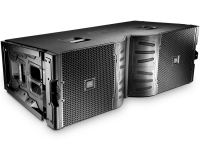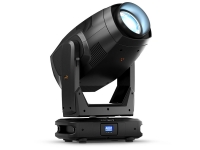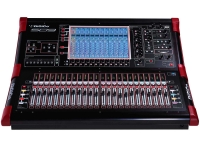ABOUT THE PRODUCT
ABOUT THE MANUFACTURER
GLOSSARY
RLM R6+
Barco`s RLM R6+ is the most cost-effective projector on the market today that can offer the excellent color quality of three-chip DLP technology with a high-brightness light output strong enough for most medium-sized venues.
Engaging, dynamic presentations
The RLM R6+ projector is an ideal companion for large-screen or auxiliary screen projection. Through its flexible picture-in-picture capabilities, you can render your events interactive and energizing without having to buy extra peripherals.
Guaranteed durability
Barco`s RLM R6+ comes equipped with an intelligent dual lamp system. If one lamp should reach end of life, the second lamp is activated without missing a beat, and without requiring human intervention. This ensures smooth, continuous presentations with a minimum amount of maintenance, and demonstrates why the RLM R6+ has proven its status as most cost-effective three-chip DLP projector time and again.
Professional used lighting equipment.| Professional second hand lighting equipment.| Professional pre owned lighting equipment.
Professional used audio equipment.| Professional second hand audio equipment.| Professional pre owned audio equipment.
Second hand audio gear. | Second hand lighting.
Pro audio equipment, second hand amplifiers, DJ, second hand sound systems, second hand Microphones, second hand Media Players.
Outdoor & Indoor LED screens for sale, LED mobile truck.
Light trussing, Gebrauchte Veranstaltungstechnik, used stage equipment Stage & Theatre lighting products.
Used BARCO
Barco NV is a Belgian technology company that specializes in digital projection and imaging technology, focusing on three core markets: entertainment, enterprise, and healthcare.It employs 3600 employees located in 90 countries. The company has 400 granted patents.
Barco is headquartered in Kortrijk, Belgium, and has its own facilities for Sales & Marketing, Customer Support, R&D and Manufacturing in Europe, North America and Asia-Pacific. Shares of Barco are listed on Euronext Brussels.Barco sells its ClickShare products to enable wireless projection from sender devices to receiver displays.Barco is an acronym that originally stood for Belgian American Radio Corporation.
Barco was founded in 1934 in the town of Poperinge, in the Flemish-speaking region of Belgium. Founder Lucien de Puydt's initial business was to assemble radios from parts imported from the United States – hence the name of his company, the Belgium American Radio Corporation, or "Barco". Radio pioneer Camiel Descamps gave the company a new start in 1941 in Kortrijk after founder Lucien Depuydt died. His wife Maria-Anna Reyntjens and his brother-in-law Joseph Versavel assisted him. Later on, also Elie Timmerman joined them. Starting from their office in Kortrijk, the company started to grow and spread around 90 countries across the globe.
In 1949, Barco started developing a multi-standard television that accepted different signal standards, becoming a leader in that field. A jukebox called Barc-O-Matic was sold from 1951. In 1967, it was one of the first European companies to introduce color TV. Building on this, it then entered the professional broadcast market in the late 1960s, supplying TV monitors to broadcasters.
From the 1960s onwards, Barco branched out into numerous other activities, which included mechanical components for industrial use, and quality control monitoring for the textile and plastics industries. In 1967, Barco became the first European manufacturer to produce transistor-based portable televisions.
Barco first entered projection technology in 1979 when it pioneered the development of cathode ray tube (CRT) projection aboard airplanes. Over the following years, it gradually focused solely on professional markets. In the mid-1980s, Barco became a main projection technology supplier for computer giants IBM, Apple and Hewlett-Packard. In the late 1980s, it entered the Brussels stock market. By 1991, Barco's market share in the graphics projection market alone reached 75%, and the company had established offices across the world, including regional headquarters in the United States and East-Asia. Through the 1990s and the first decade of the new millennium, Barco developed and marketed new display technologies such as liquid crystal display (LCD), light-emitting diodes (LED), Texas Instruments' Digital Light Processing (DLP), and later, liquid crystal on silicon (LCoS). It now covers markets that include media and entertainment, security and monitoring, medical imaging, avionics, 3D and virtual reality, digital cinema, traffic control, broadcast and training and simulation.
In 2018, Barco entered into a joint venture with China Film Group Corporation (CFG), Appotronics and CITICPE to commercialize each company's products and services for the global cinema market excluding mainland China: Cinionic. In Barco's case, this involved the company's cinema projectors.
Professional used lighting equipment.| Professional second hand lighting equipment.| Professional pre owned lighting equipment.
Professional used audio equipment.| Professional second hand audio equipment.| Professional pre owned audio equipment.
Second hand audio gear. | Second hand lighting.
Pro audio equipment, second hand amplifiers, DJ, second hand sound systems, second hand Microphones, second hand Media Players.
Outdoor & Indoor LED screens for sale, LED mobile truck.
Light trussing, Gebrauchte Veranstaltungstechnik, used stage equipment Stage & Theatre lighting products.
Negative Gain Screen: Material that reflects less light than a reference material. Often used for DLP and LCD projection systems.
Nonlinear Editing: Digital video systems that allow for clips to be extracted without affecting the master recording.
NTSC: National Television Standards Committee. Government-directed committee that established the U.S. color TV standard in 1953. Also known, sarcastically, as Never Twice the Same Color or Never The Same Color due to the inherent difficulty in achieving proper color calibration.
Outcue/Outq/Out-Point: These words all refer to the final few seconds of audio signifying the conclusion of the production.
Package: A completed and fully edited video piece.
Phase: Time relationship between signals it`s all relative.
PIP: Picture-in-picture.
Pixel: Contraction of picture element. The smallest element of data in a video image.
Plasma: Flat-panel display technology that ignites small pockets of gas to light phosphors.
Progressive Scanning: Each frame of a video image is scanned complete, from top to bottom, not interlaced. For example, 480p means that each image frame is made of 480 horizontal lines drawn vertically. Computer images are all progressively scanned. Requires more bandwidth (twice as much vertical information) and a faster horizontal scan frequency than interlaced images of the same resolution.
Projection System: Display that projects image onto a screen.
Raw Edit/Rough Cut: Video edited together without a voiceover, oncamera announcer or text so that separate narration or audio can be added.
Rear Screen Projection: A process of projection where an image is projected on the back surface of a screen placed between the audience and the projector. This allows for a very clean front-of-the-house look in your meeting room because all production equipment is in the back-of-the-house, behind the screen.
RGB: Red, Green, Blue. Can refer to an unprocessed video signal or the color points of a display device. Together these three colors make up every color seen on a display device.
RPTV: Rear-Projection Television.
Scan Lines: The lines drawn by an electron gun in a CRT system to make up the picture. Drawn horizontally, from left to right, starting at the top left and working to the bottom right.
SDTV: Standard Definition Television. Lower-resolution subset of the ATSC`s DTV system. 480i is typically accepted as an SD signal. Digital broadcasters can offer multiple sub-programs at SDTV quality, as opposed to one or two HD programs. Digital satellite and digital cable often refer to the majority of their programs as SDTV, somewhat erroneously, as neither system has anything to do with DTV, though both, technically, consist of a digital 480i signal.
Sigout: The final words of a segment used to signify the production`s conclusion.
Source: A component from which the system`s signals originate. DVD player, AM/FM tuners, and VCRs are sources: 2 Pull-down Recognition or 3:2 Inverse Telecine: Film is usually recorded at 24 frames per second. NTSC video (North America) is 30 frames (60 fields) per second. In order to get smooth motion, the film frames are broken into video fields in a 3-2-3 sequence. 3 fields for the first film frame, 2 fields for the second film frame, and so on. If a line doubler doesn`t compensate for the extra field during playback on a progressive-scan display, the image will have noticeable motion artifacts. A line doubler with 3:2 pull-down recognition or 3:2 inverse telecine can see this sequence in the signal and correct for it by making sure the last field in the first frame isn`t mixed with the first field of the second frame.
Standup: The portion of video in which the reporter directly speaks into the camera. If a standup concludes a package, it contains a sigout. If other video precedes and follows a standup, the segment is referred to as a bridge.
Uniformity: Even distribution across a given space. In video, uniformity can refer to the distribution of light (hot spotting) or color.
Unity Gain: Output that equals the input. Unity gain screen material reflects as much light as the reference material. Has an even dispersion of light.
UHD:Ultra-high-definition television (also known Ultra HD television,Ultra HD,UHDTV,UHD and Super Hi-Vision) today includes 4K UHD and 8K UHD.
User-Generated Content (UGC): Text, photos, video or audio supplied by the customers of a company.
Video Mapping: A technology to "paint" multiple video sources onto a stage or building where the image can be tightly trimmed around stage or building elements without necessarily needing multiple video projectors. Used to animate a stage set, change the entire mood of an event in real-time and provide an added wow factor.
Voice-over (VO): Verbal audio played over video.
Wall-to-Wall Coverage: A continuous broadcast report of a single story with few to no interruptions, usually reserved for particularly significant stories.
Y/C: Abbreviation for luminance/ chrominance, aka S-video signal. Color and detail signals are kept separate, thus preventing composite video artifacts. Cable uses four-pin connector. Used with S-VHS VCRs, DVD players, Hi-8, and DBS receivers.
Professional used lighting equipment.| Professional second hand lighting equipment.| Professional pre owned lighting equipment.
Professional used audio equipment.| Professional second hand audio equipment.| Professional pre owned audio equipment.
Second hand audio gear. | Second hand lighting.
Pro audio equipment, second hand amplifiers, DJ, second hand sound systems, second hand Microphones, second hand Media Players.
Outdoor & Indoor LED screens for sale, LED mobile truck.
Light trussing, Gebrauchte Veranstaltungstechnik, used stage equipment Stage & Theatre lighting products.































